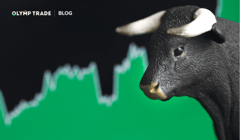
Energy prices are still high, USD is strengthening and Gold is becoming less appealing to investors.
Interact with the dashed blue word and green spot on images to get additional details and explanations.
More details on the visuals will be here.
A term definition or explanation will be here.
Contents
Weekly Trends
Tesla ↓ -12.62%
Trading Down with a $100 and a X20 multiplier on Forex Olymp Trade, you could have easily made $252.
GBP/USD ↓ -4.37%
Trading Down with a $100 and a X500 multiplier on Forex Olymp Trade, you could have easily made $2185.
EUR/JPY ↑ 2.16%
Trading up with a $100 and a X500 multiplier on Forex Olymp Trade, you could have easily made $1080.
Currency Markets
The Market is Affected by the Russia-Ukraine Conflict, CPI Data, and the Covid-19 Outbreak
While the USD rose to its highest levels since the pandemic began more than 2 years ago, other currencies moved down.
On Wednesday, April 27, at the beginning of the European session, the USD traded at its highest levels in two years on safe-haven demand. Global investors were mostly reacting to the geopolitics and the prospects of further tightening by the Federal Reserve. The price made its strongest moves since March 2020 and may be making its best month since 2015.
On the same day, EUR dropped below $1.06 for the first time in five years. Generally, in April, EUR moved down more than 4% and headed for its worst monthly loss in more than seven years. Energy security concerns and slowing growth in China and Europe are among the main reasons. Particularly, when Russia's Gazprom said it would cut gas supplies to Poland and Bulgaria, EUR moved down to a five-year low. With the background of the deepening Russia-Ukraine crisis and the stalemate over fuel payments, the prospect of Russia stopping gas flows to Poland and Bulgaria may keep putting downward pressure on EUR and further strengthen USD’s safe-haven growth.
Germany's yearly economic growth outlook for 2022 was revised to 2.2%, down from the forecast of 3.6% in January. The revision reflects the challenges faced by consumers in the country, record prices, and uncertainty for businesses. The forecast for 2023 is 2.5%.

AUD started going up after last week’s downward movement. Australian inflation keeps growing, with the year-on-year CPI in Q1 rising to 5.1% after Q4’s 3.5%. The Q1 beat the consensus of 4.6% and was the highest since the GFC in 2008. With the menace of growing inflation, the Reserve Bank of Australia will likely hike rates to halt it. However, the RBA will probably wait for the federal elections in May to end before it starts any major move in the monetary policy. The plan will be discussed next week.
USD Hits its Highest Level
Expectations of the Federal Reserve’s tighter policies and safe-haven demand boosted the USD.
On Wednesday, April 27, USD rose to its highest level since the COVID-19 pandemic began and was set for the best month since 2015. Mostly, it was due to prospects of aggressive rate hikes in the US and global investors’ shift towards safe-haven assets.

EUR/USD made a steep drop after its last swing high at 1.09356 on April 21. The recently hit level of 1.04383 is the lowest since March 2017. On the daily chart above, the decline will likely test the downward trend near a strong psychological level of 1.0500. We believe EUR/USD will keep going down in the near term, especially if it breaks the mentioned support level.
AUD/USD is Going Down
AUD/USD is staying down in the zone of two-month lows.
The rate hike prospects reinforced by the growing inflation report boosted AUD. In this regard, CPI is key to measuring inflation and assessing the shifts in consumer trends. Usually, if the CPI is going up, it pushes the AUD to the upside. A low reading drags the currency down.
As AUD is a risk-sensitive currency, a surge in risk concerns weighed on it and brought it to two-month lows. Particularly, obstacles in the way of China’s economic growth such as the consequences of the zero-Covid policies may disrupt supply chains and impact the Australian economy.

While AUD/USD currently presents mixed trends, it will likely move towards 0.7100. The price needs to consolidate below this level to keep the negative scenario active. In this case, we recommend traders wait for indications of further moves toward the downward target levels of 0.7050 and 0.6990. The RSI indicator shows that the price has started to move into the oversold zone, confirming the possibility of a downward scenario.
Stock Markets
The Stock Market is Trying to Recover from the Earlier Sell-off
US stocks edged higher, making most major indexes regain some of their losses after a sell-off in the previous session.
April has historically been a strong month for stocks. Previously, in 15 of the past 16 years, the S&P 500 gained in April. But this time, the Russia-Ukraine conflict, the Federal Reserve's rate hike, growing inflation, and disruptions in supply chains may all put too much pressure on the economy.
In Europe and Asia, major stock indexes have been mostly falling on continued fears that the COVID outbreak in China will lead to lockdowns and global supply chain disruptions. US stock futures moved up, helping major indexes regain some of their losses on Wednesday after the previous session’s sell-off. Futures for the S&P 500 were up 0.4%, and the Dow Jones Industrial Average was up 0.6%. The contract for the technology-focused Nasdaq-100 rose 0.2%.
On a year-to-year basis, the S&P 500 is down 12% and the Nasdaq Composite is down 20%. On Tuesday last week, the Nasdaq Composite posted its biggest one-day percentage drop since September 2020. Dow was also down below 800 points as investors were assessing the earnings reports and factoring in inflation, the US Fed’s tight policy outlook, and the spread of Covid-19 in the US.

US equity futures edged higher in pre-market trading on April 28 after a choppy previous session as the market attempted to recover from a sell-off earlier this week.
Google Stock Goes Down as the Company Misses on Revenue
Google moved down after the company reported worse-than-expected financial results.
Google's parent company, Alphabet, began reporting on the mega-cap tech names and revealed first-quarter sales that roughly matched forecasts. The tech giant’s primary search and YouTube advertising business have presented financial resilience. Nevertheless, the stock was down about 4% in extended trading.

Price target.
The world's largest search engine and video provider made a fortune over the past two years as the pandemic forced more businesses and people online. This year, beating those sales may be difficult due to the Russia-Ukraine conflict, rising inflation, and product shortages causing advertisers to abandon marketing campaigns.
Currently, the stock is down at $2,290, which is its lowest level since May 2021. On lower time frames, the RSI indicator shows that the price is already in the oversold zone. That means it’s too low and may go into an upward correction in the near future. Therefore, we believe the stock will move up in the next few weeks.
Commodity Markets
Commodities are Pressed by the Russia-Ukraine Conflict and COVID Cases
Brent is trading flat due to mixed supply and demand. Together with the conflict between Ukraine and Russia that sees no near resolution, the new spike in coronavirus cases in China is pressing on the oil demand and dragging the oil price down. At the same time, as Russia is one of the largest oil producers, the sanctions put on it are driving the oil price upwards. Together, these opposing factors made the price settle in the zone of historic highs.

Currently, Brent oil trades around $104 per barrel, with the broken up trend line from November 2021 serving as a resistance level. The World Bank Group believes the price will likely stay above $100 and average at this level through the entire year. For this week, the support level is at $100 and the resistance level is at $109.

Resistance target at $109
Support target at $100
Uptrend line resistance
Uptrend line support
So far, the price of Natural Gas has been elevated as Russia has cut off gas supplies to Bulgaria and Poland because those countries refused to pay for it in Russian rubles. Last Monday, the price dropped to 6.482 and touched the uptrend line from mid-March but closed the day near $7 MMBTU. We believe prices will likely stay elevated with this week’s support targets around $7 and resistance at $7.763 and $8.

Resistance target at $8
Resistance target at $7.763
Support target at $6.5
Trend line up with support at $7
Higher US Dollar Makes Gold Lose Demand
FOMC Hawks dampen the outlook for Gold investors. Except for just two days during this month, the Basic Dollar Index has been trading up throughout the entire of April starting from the last day of March. BDI reached 104.038, and breaking this level opens the way to the price zone last seen in 2002.

The increase in the US Dollar is due to the upcoming FOMC meeting on May 4. The Federal Reserve is expected to raise the interest rate by 50 basis points, bringing the key interests up to 1%. As the US Dollar rises, Gold may become less attractive to foreign investors. Last Monday, Gold broke below the 50% Fibonacci level and is now challenging the 61.8% Fibo level downwards. This week’s support target can be at $1,850 per troy ounce and the resistance will be the 50% Fibonacci level at $1,925.

Resistance target at $1,925
Support target at $1,850
Cryptocurrency Markets
Crypto Assets are Pressed by Economic Turmoil
The crypto industry is gradually changing the world. Goldman Sachs is one of the leading banks that is supportive of cryptocurrencies and is now offering its first bitcoin-backed loans. In Central America, Panama takes steps to regulate the use of crypto-assets. Mexico now has a total of 14 Bitcoin ATMs with the new installation in Mexico's Senate building. The Central African Republic is also aiming to become the second country after El Salvador to legalize and adopt Bitcoin as an official legal tender. While all of this is good news for digital currencies, the Bitcoin Fear and Greed index remains in extreme fear with a reading of 23. The global market capitalization of cryptocurrencies is $1.81T, down from 1.88T last week.

The Current Resistance Level for Bitcoin is $40,000
Last week, Amazon dismissed allegations that the platform is planning to accept Bitcoin as a means of payment. Against this backdrop and the global market turmoil, Bitcoin and Ethereum dropped below major support levels. Bitcoin is now trading below $40,000, and this is now its resistance level. Ethereum is trading below $3,000. In the crypto world, there is a saying, “buy the fear and sell the greed”. According to it, now may be a good opportunity to invest in cryptocurrencies as the price is relatively low. Last week, Bitcoin dropped to $37,708. Although it has later recovered some of the losses, it still trades below the critical level of $40,000. For this week, the support level will be at $38,000, and the resistance level will be at $40,000. Breaking the latter upwards may take the uptrend to the targets of $43-45,000.

Resistance target of $43,000
Support target of $36,350
Uptrend line resistance
Uptrend line support
Risk warning: The content of the article does not constitute investment advice and you are solely responsible for your trading activity and/or trading results.
A safe haven is a type of investment that is expected to retain or increase in value during times of market turbulence.
The US Federal Reserve, or the Fed, acts as the US central bank and regulates the country’s monetary and financial system.
The S&P 500 index is one of the best gauges of the largest US public companies’ collective performance and, therefore, that of the stock market in general.
Supply chains generally refer to the process of moving and delivering products and services from their place of production to customers.











